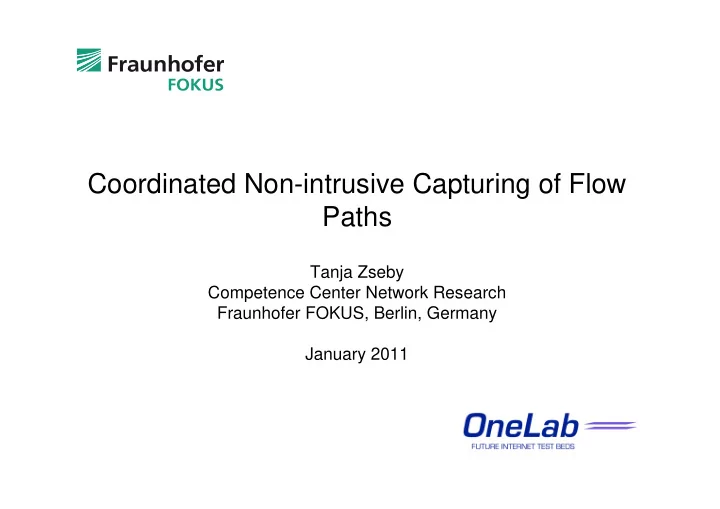

Coordinated Non-intrusive Capturing of Flow Paths Tanja Zseby Competence Center Network Research Fraunhofer FOKUS, Berlin, Germany January 2011
Motivation • Traffic Observation – Network operation (management, security,..) – Information to users (quality, path) – Adaptive network algorithms • Answering questions – routes that are followed by my flows through the network – delays and losses that occurred between nodes – quality that was experienced by my traffic
Coordinated Traffic Observation • H op-by-hop path and quality of packet delivery Quality Path • Coordinated network observation • Non-Intrusive measurement method
Capturing the Path s A - sequence t A - arrival time Calculate Path, Delay,… c A – content (header+payload Packet ID Packet ID Generation Generation <s B , t B , c B > <s A , t A , c A > Correlation of events at different observation points Correlation of events at different observation points based on packet ID (from parts of packet content) based on packet ID (from parts of packet content)
Challenge: Coordinated Data Selection Select same packet at different observation points Select same packet at different observation points <s B , t B , c 1 > <s B , t B , c 1 > <s A , t A , c 1 > Selection Processes: Filtering: f(c i ) parts on c remain can select same packets Sampling: f( s i ) or f(t i ,) s, t change cannot select same
Hash-based Selection [RFC5475] Goal: Select same packet at different observation points Goal: Select same packet at different observation points c 1 Packet Content: Hash-function Hash-value: [ ] [ ] f( c 1 )=1 f( c 1 )=0 Selection Decision: Duffield, Grossglauser: Trajectory Sampling, 2001 [RFC 5475] Zseby, Molina, Duffield, Niccolini, Raspall. Sampling and Filtering Techniques for IP Packet Selection, RFC 5475, Standards Track, March 2009.
Challenges Goal: Emulate random selection • Problem1: Some content not suitable Content Selection • Problem2: Predictability of selection decision Detection Avoidance • Problem3: Deterministic operation Biased Selection • Problem4: Variability of traffic Sample size variation
Suitable Content Criterion1: Invariant on the path X Criterion1: Invariant on the path Theoretical IP Version IHL TOS Total Length Identification Flags Fragment Offset X X TTL Protocol Header Checksum Source Address Destination Address Options Padding TCP Source Port Destination Port Sequence Number Acknowledgement Number Offset Reserved Control Flags Window Checksum Urgent Pointer Options Padding Payload Higher Layer Data …
Suitable Content Criterion2: Variable among packets Theoretical and Empirical X X X IP Version IHL TOS Total Length X Identification Flags Fragment Offset X X TTL Protocol Header Checksum Source Address Destination Address Options Padding TCP Source Port Destination Port Sequence Number Acknowledgement Number Offset Reserved Control Flags Window Checksum Urgent Pointer Options Padding Payload Higher Layer Data …
Coordinated Packet Selection • Problem1: Content selection (further challenges) – IPv6 different fields, few data available – Middlebox operations (e.g., NAT) • Problem2: Predictability of selection decision – [Goldberg&Rexford, 2007]: Crypto-strong PRF with secret key • Problem3: Bias – Traffic Dependent (!) • Problem4: Sample size variation – Adaptation to CPU load but further investigations needed
Adaptation of Parameters IPFIX Parameter (path, delay,…) adjustment Collector: Calculate Path, Delay,… IPFIX (id, timestamp, sample rate,..) ID generation Measurement ID generation Process Hash-based selection Hash-based selection timestamping timestamping
Advantages • Non-intrusive – No test traffic, no side effects – Quality statement about real traffic SLA validation • Controllable costs – Sampling parameter adjustment – Heterogeneous/federated environments • Privacy-preserving – Sampling and aggregation, no DPI • Standardized data export (IPFIX) – Comparability of results, re-usability of tools, traces – Reduction of errors from conversion steps 12 of 47
Main Contributions • Investigations on suitable hash-functions – Statistical properties, performance [HeSZ08] • Sampling parameter adjustment – Adjust accuracy and resource consumption – Coordinate parameter settings in heterogeneous/federated environments • Contributions to Standardization • Deployment in experimental facilities • Open Source Packet Tracking Software HeSZ08] Henke, Schmoll, Zseby: Empirical Evaluation of Hash Functions for Multipoint November 2010 T. Zseby 13 of 47 Measurements, ACM Comput. Commun. Rev. CCR 38, 3, July 2008.
Standardization is Crucial • Provide comparability of results – Allow comparison of results Imperial – Provide reference data or metric ??? • Reduce Costs – Common interfaces for analysis tools – Re-usage of archived data • Reduce errors – Avoid error-prone conversion steps – Gain experiences with only one format
PlanetLab 1 0 1 1 nodes around the w orld 1 0 1 1 nodes around the w orld 3 5 countries 3 5 countries 4 7 6 sites ( universities, research labs) 4 7 6 sites ( universities, research labs) m ore than 1 0 0 0 researchers m ore than 1 0 0 0 researchers Picture from www.planet-lab.org
PlanetLab Europe • PlanetLab Nodes in Europe – PLE Control in Paris (UPMC) – In cooperation with PlanetLab Central, Princeton – PLE users have access to whole PlanetLab – Profit from additional testbeds and new tools • Supported by the EU FIRE Project OneLab – Development of new tools for PLE users – Integration of new testbed types: wireless, autonomic, DTNs, etc. – Federation with other testbeds • http://www.planet-lab.eu/
Demonstration
Future Work • Deployment in Future Internet testbeds – Support for experimentere – OneLab, G-Lab, Federica, KOREN, ..) • Solutions for IPv6 – Different Header fields – Different traffic patterns new recommendations for hash functions • New Applications – Support for Routing Security
Contact: tanja.zseby@fokus.fraunhofer.de Thank you!
Recommend
More recommend